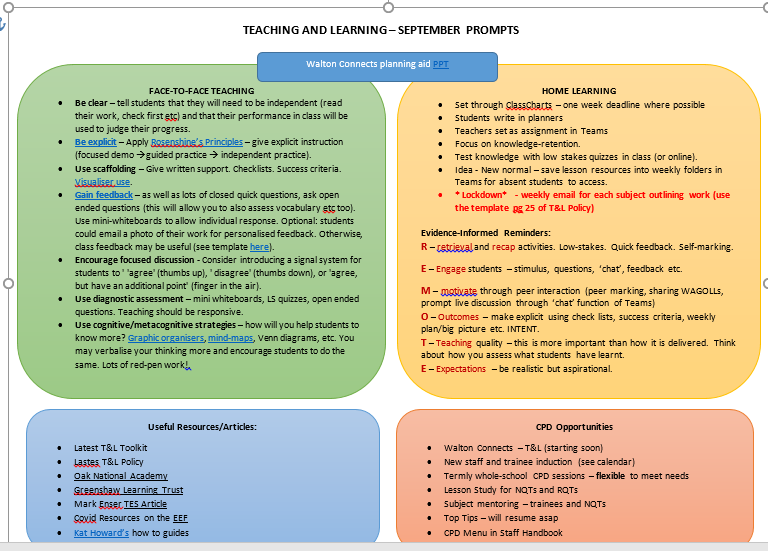6 September 2020

WoW – accumulation CPD Focus – Reading and Vocabulary
This Week:
Thank you for your hard work and effort in ensuring that brilliant learning, facilitated by brilliant teaching, happens within your classrooms.
- Pastoral Top Tip this week – see attached sheet for which many thanks!
- Homework club starts this week for all year groups
Looking ahead: Trainees (Eng, His, MFL, PE) – due to start with us on 21st September. Virtual welcome with subject mentors (RHO, JGA, LEA, JMI) on 17th or 18th September – TBC.
Reflect…
Link to this term’s CPD focus – Reading for Understanding
As we return to our classrooms and try to evaluate the starting points of the students within our classrooms, it seems a fitting time to reappraise our own use of questioning.
“I cannot teach anybody anything, I can only make them think.” Socrates
Use of questioning is going to be fundamental and what often seems like an informal discussion within a classroom context often proves to be enlightening in allowing us to judge the student’s grasp of a concept or threshold knowledge. The following questions, taken from SecEd, are a useful reminder for us all and will allow us to probe more deeply into our students’ knowledge and understanding.
There are six types of Socratic question which should be used in order. They are as follows (saved as a handy sheet here – feel free to print):
1 Conceptual clarification questions
The first type of Socratic question is used in order to get students to clarify their thinking. These questions might be:
- “Why do you say that?”
- “What exactly does this mean?”
- “Could you explain that further?”
- “What do we already know about that?”
- “Can you give me an example?”
- “Are you saying ... or ... ?”
- “Can you rephrase that, please?”
2 Probing assumptions questions
The second type of Socratic question is used in order to challenge students about their pre-existing assumptions, and to make them think about their hitherto unquestioned beliefs. This might include the following questions:
- “Is that always the case?”
- “Why do you think that assumption holds here?”
- “Please explain why/how ... ?”
- “How can you verify/disprove that assumption?”
- “What would happen if ... ?”
- “Do you agree or disagree with ... ?”
3 Probing rationale, reasons and evidence questions
The third type of Socratic question is used in order to uncover – and interrogate – the evidence or reasoning upon which students base their argument. In practice, a teacher might ask:
- “Why do you say that?”
- “Is there reason to doubt the evidence?”
- “How do you know this?”
- “Show me ... ?”
- “Can you give me an example of that?”
- “Are those reasons good enough?”
- “How might it be refuted?”
4 Questioning viewpoints/perspectives questions
The fourth type of Socratic question is used in order to explore alternative points of view and, importantly, to show students that there are other, equally valid viewpoints. This might include asking the following questions:
- “What is the counter-argument?”
- “Can anyone see this another way?”
- “What is the difference between ... and ...?”
- “Why is it better than ...?”
- “What are the strengths and weaknesses of ...?”
- “How are ... and ... similar?”
- “How could you look another way at this?”
5 Probing implications and consequences questions
The fifth type of Socratic question is used in order to explore the implications and consequences of an argument, and to consider whether the argument makes sense and if its consequences are desirable. In practice, this might include the following questions:
- “But if ... happened, what else would then result?”
- “How does ... affect .... ?”
- “What are the implications of ... ?”
- “How does ... fit with what we learned before?”
- “Why is ... important?”
- “What is the best ... ? Why?”
6 Questioning the question questions (if you see what I mean).
The sixth and final type of Socratic question is used in order to question the initial question. This involves students in understanding why the teacher asked the question he/she did and perhaps proposing alternative questions. For example, the teacher might ask:
- “Why do you think that I asked that question?”
- “Why was that question important?”
- “Am I making sense? Why not?”
- “What else might I ask?”
- “What does that mean?”
Remember also our Deeper Questioning grid in your staff planners in the T&L Toolkit, page 4).
The Remote Learning Policy remains unchanged from July. Please provide tweaks or amendments to RLO asap if needed.
The Teaching and Learning Policy has been updated and now contains a Section Two Pandemic section. Please read and use the one page summary to help you to refine your approach.
TOP TIPS
Reminder - Top Tips are going to be vital in coming weeks and months. Thanks to the Pastoral Team for their top tip. Read in full here. The key Top Tip 5 Takeaways are:
|
Top Takeaway Tips: 1. Be kind and non-judgemental 2. Remember that you are human 3. Talk about your feelings 4. Self-care (physical and emotional) 5. Ask for help if needed |
Next week's Top Tip is from the SEND department.
|
|
CPD CASCADE
Reminder – please see the updates from last week’s Teaching and Learning Digest
Free Online Well-being CPD Opportunity (thanks to RSW)
ACEs online (thanks to RSW)
OneNote online exercise books – useful for feedback (thanks to JMO)
- ![]() OneNote - Digital Exercise Books.docx
OneNote - Digital Exercise Books.docx
Quick tutorial for setting homework in ClassCharts (thanks to DMC)
Posted by Rachel Long
Category: Teaching and Learning Digests
